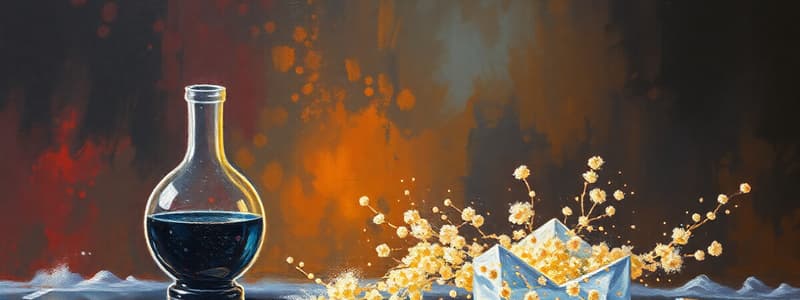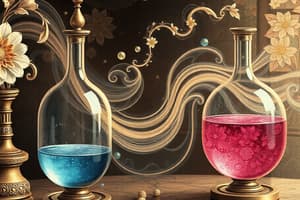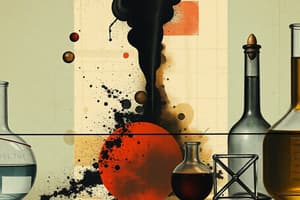Podcast
Questions and Answers
What characterizes dynamic equilibrium in a chemical reaction?
What characterizes dynamic equilibrium in a chemical reaction?
- Only the forward reaction is occurring.
- The concentrations of reactants and products change over time.
- The forward and reverse reactions occur at different rates.
- The concentrations of reactants and products remain constant. (correct)
How does the common ion effect influence solubility?
How does the common ion effect influence solubility?
- It increases the solubility of sparingly soluble salts.
- It only affects insoluble salts.
- It has no effect on the solubility of salts.
- It decreases the solubility of slightly soluble salts. (correct)
What does the equilibrium constant indicate in ionic equilibrium?
What does the equilibrium constant indicate in ionic equilibrium?
- The concentration of hydroxide ions in pure water.
- The extent of ionization or solubility for a given reaction. (correct)
- The rate of ionization of strong acids only.
- The temperature dependency of reactions.
Which of the following correctly describes buffer solutions?
Which of the following correctly describes buffer solutions?
Which factor typically does NOT affect the position of equilibrium in a reaction?
Which factor typically does NOT affect the position of equilibrium in a reaction?
What happens to the position of equilibrium when the concentration of a product is decreased?
What happens to the position of equilibrium when the concentration of a product is decreased?
If an endothermic reaction at equilibrium is subjected to an increase in temperature, what is the expected effect on the reaction?
If an endothermic reaction at equilibrium is subjected to an increase in temperature, what is the expected effect on the reaction?
Which statement about equilibrium constants (K) is TRUE?
Which statement about equilibrium constants (K) is TRUE?
How does increasing pressure affect a gaseous reaction at equilibrium?
How does increasing pressure affect a gaseous reaction at equilibrium?
According to Le Chatelier's Principle, what will occur if a catalyst is added to a system at equilibrium?
According to Le Chatelier's Principle, what will occur if a catalyst is added to a system at equilibrium?
If a reaction at equilibrium produces more heat than it consumes, what kind of reaction is it considered to be?
If a reaction at equilibrium produces more heat than it consumes, what kind of reaction is it considered to be?
What occurs when the concentration of a reactant is increased in a reaction at equilibrium?
What occurs when the concentration of a reactant is increased in a reaction at equilibrium?
The equilibrium constant expression for the reaction $aA + bB \rightleftharpoons cC + dD$ is given by which formula?
The equilibrium constant expression for the reaction $aA + bB \rightleftharpoons cC + dD$ is given by which formula?
Flashcards
Dynamic Equilibrium
Dynamic Equilibrium
A state where forward and reverse reactions occur at equal rates, resulting in constant reactant and product concentrations.
Ionic Equilibrium
Ionic Equilibrium
Equilibrium between ions and undissociated molecules in solution, like weak acid/base dissociation or salt precipitation.
Common Ion Effect
Common Ion Effect
Decreased solubility of a salt when a soluble salt with a common ion is added.
Buffer Solutions
Buffer Solutions
Signup and view all the flashcards
Equilibrium Constant (Ionic Reactions)
Equilibrium Constant (Ionic Reactions)
Signup and view all the flashcards
Equilibrium
Equilibrium
Signup and view all the flashcards
Le Chatelier's Principle
Le Chatelier's Principle
Signup and view all the flashcards
Equilibrium Constant (K)
Equilibrium Constant (K)
Signup and view all the flashcards
Effect of Concentration Change
Effect of Concentration Change
Signup and view all the flashcards
Effect of Pressure Change
Effect of Pressure Change
Signup and view all the flashcards
Effect of Temperature Change
Effect of Temperature Change
Signup and view all the flashcards
Catalyst Effect
Catalyst Effect
Signup and view all the flashcards
Equilibrium Constant Formula
Equilibrium Constant Formula
Signup and view all the flashcards
Study Notes
Equilibrium
- Equilibrium is a state where the rates of the forward and reverse reactions are equal.
- At equilibrium, the net change in concentrations of reactants and products is zero. This does not mean that the forward and reverse processes have stopped, rather that the rate of each process is equal.
Le Chatelier's Principle
- Le Chatelier's Principle states that if a stress is applied to a system in equilibrium, the system shifts in a direction that relieves the stress.
- The stress can involve changes in concentration, pressure, temperature, or the addition of a catalyst.
- Increasing the concentration of a reactant shifts the equilibrium to the right (favoring product formation).
- Decreasing the concentration of a product has the same effect.
- Increasing the pressure on a gaseous system shifts the equilibrium to the side with fewer moles of gas.
- Increasing the temperature shifts the equilibrium in the direction that absorbs heat (endothermic reaction).
- Adding a catalyst speeds up both the forward and reverse reactions, but does not affect the position of equilibrium.
Equilibrium Constants
- Equilibrium constants (often denoted by K) quantify the relative amounts of products and reactants at equilibrium.
- The numerical value of K depends on the specific reaction and the temperature.
- For the general reversible reaction aA + bB ⇌ cC + dD, the equilibrium constant is defined as: K = ([C]^c * [D]^d) / ([A]^a * [B]^b), where the square brackets denote molar concentrations.
- Large K values mean that the reaction strongly favors product formation.
- Small K values mean that the reaction strongly favors reactant formation.
Factors Affecting Equilibrium
- Concentration Changes: Adding more reactants or removing products drives the reaction towards products. Removing reactants or adding products shifts the reaction towards reactants.
- Pressure Changes (for gaseous reactions): Increasing the pressure shifts the reaction towards the side with fewer moles of gas. Decreasing the pressure shifts the reaction towards the side with more moles of gas.
- Temperature Changes: Increasing the temperature shifts the equilibrium in favor of the endothermic reaction (the reaction that absorbs heat). Decreasing the temperature shifts the equilibrium in favor of the exothermic reaction (the reaction that releases heat).
- Catalysts: Catalysts speed up both the forward and reverse reactions equally, without changing the position of equilibrium.
Dynamic Equilibrium
- Dynamic equilibrium is the state where the forward and reverse reactions occur at equal rates.
- The concentrations of reactants and products remain constant over time because the rate of the forward reaction equals the rate of the reverse reaction.
Ionic Equilibrium
- Ionic equilibrium deals with the equilibrium between ions and undissociated molecules in solution.
- Examples include the dissociation of weak acids and bases, and the precipitation of sparingly soluble salts.
- The equilibrium constant for such reactions describes the extent of ionization or solubility.
- Common ion effect: The solubility of a slightly soluble salt is decreased when a soluble salt containing a common ion is added to the solution.
- Buffer solutions resist changes in pH. They typically contain a weak acid and its conjugate base, or a weak base and its conjugate acid.
Studying That Suits You
Use AI to generate personalized quizzes and flashcards to suit your learning preferences.




